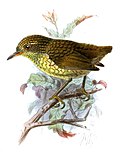This article includes a list of references, related reading, or external links, but its sources remain unclear because it lacks inline citations .(August 2017) |
| Cinclodes | |
|---|---|
 | |
| Buff-winged cinclodes (C. fuscus) in Argentina | |
| Scientific classification | |
| Kingdom: | Animalia |
| Phylum: | Chordata |
| Class: | Aves |
| Order: | Passeriformes |
| Family: | Furnariidae |
| Genus: | Cinclodes G.R. Gray, 1840 |
| Type species | |
| Motacilla patagonica Gmelin, 1789 | |
| Species | |
See list | |
Cinclodes is a genus of passerine birds belonging to the ovenbird family Furnariidae. There are about a dozen species distributed across the southern and Andean regions of South America. They are terrestrial birds of open habitats, typically found near water such as mountain streams or the seashore where they forage for small invertebrates. They are stocky birds with strong legs and feet and pointed, slightly downcurved bills. The plumage is inconspicuous and mainly brown, often with a pale wingbar, stripe over the eye and corners to the tail. They have loud, trilling songs and often raise their wings while singing.











